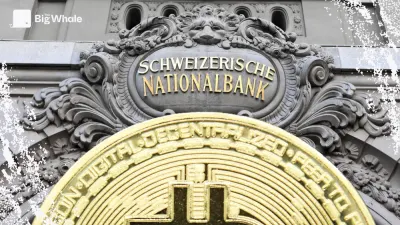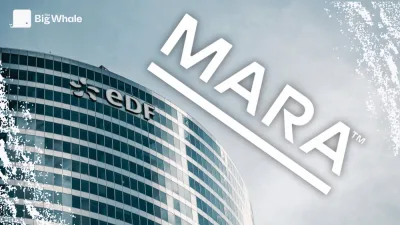TBW - Restaking: After the euphoria, this vertical is still looking for its model

In the world of decentralised finance (DeFi), a trend has been attracting the attention of seasoned investors for several months: restaking. Halfway between optimising returns and pooling security, this practice involves reusing crypto-currencies already involved in a staking process to generate more income - or to strengthen other decentralised infrastructures.
In practical terms, a user starts by depositing their tokens on a classic staking protocol. For example, ETH staked via Lido, which gives in exchange a liquid token called stETH. This token, representing the initial stake, can then be re-staked on other protocols such as EigenLayer, Karak or Symbiotic. These platforms enable these derivative assets to be used to secure other networks or participate in decentralised services.
The main attraction? It's the leverage effect on income. The user receives the interest from the initial staking, but also that generated by his or her secondary participation. A way of improving the return on your cryptos without raising new funds.
What are the main restaking projects?
Launched on Ethereum, EigenLayer is the first protocol to have introduced restaking on a large scale. It allows users to restake their ETH - or liquid staking tokens such as stETH - to secure decentralised services called Actively Validated Services (AVS). Benefiting from a first mover effect, EigenLayer quickly captured the attention of investors, as evidenced by its record TVL (total locked value). The protocol has also opened up to a wide variety of tokens: in addition to ETH and LST, it now accepts assets such as PEPE, Swell, stablecoins such as FRAX, and even Lombard LBTC.

>> Analysis of the EigenLayer project
Behind this behemoth is Babylon, with an estimated TVL of $4.4 billion. This protocol stands out by adapting the restaking model to Bitcoin, without using a Proof of Stake blockchain. BTC holders can thus secure third-party networks using their bitcoin as collateral, a novel approach that strengthens the bridges between the two main crypto ecosystems.

Another project to watch: Symbiotic. The brainchild of the co-founders of Lido, this protocol is based on a similar architecture to EigenLayer, but is designed to be more flexible. It allows a wide variety of assets to be restacked, including stablecoins and LBTC, and aims to stand out for its modular approach.

>> EigenLayer, Symbiotic: the restaking war has begun
On the BNB blockchain, the Kernel protocol occupies an important place. Fourth in terms of TVL, it allows users to restake their BNB or BTC in various forms, with the key being additional rewards for validators and custodians.
Finally, a new generation of protocols is emerging, like Karak, Solayer, and other projects still in development, each offering its own incentive and security mechanisms.
A dazzling hype: TVL explosion in 2024
Restaking has emerged as one of the major trends of 2024. The sector's Total Value Locked (TVL) soared spectacularly, peaking at $30 billion in December 2024 before falling back in the following weeks.
A trajectory marked by euphoria, speculation... and a general correction observed in the crypto industry.
At the origin of this wave, one name: EigenLayer. A precursor to restaking, the protocol caught the eye at the start of the year when it introduced a points mechanism designed to reward users who 'restak' their assets. This strategy, which has been widely imitated, has been a major catalyst for the craze.
In the wake of EigenLayer, several platforms offering Liquid Restaking Tokens (LRT), such as EtherFi, Renzo, Swell and Puffer, have launched their own incentive programmes. By promising - or holding out the hope - of a future airdrop, these protocols have captured the attention of a community hungry for opportunity.
>> The hidden business of airdrops: between mirage and reality
Boosted by this momentum, the ecosystem rapidly expanded with the arrival of new players such as Babylon, Karak, Symbiotic and Solayer, widening the field of possibilities and boosting the sector's overall TVL.
But after the euphoria came a return to reality: a correction occurred at the start of 2025, bringing TVL back to levels similar to those seen in autumn 2024. A drop that is part of a broader context of declining interest in crypto-assets, without erasing the impact of this new vertical on the Ethereum ecosystem.
A review of projects based on restaking
EigenDA
Developed by EigenLayer, EigenDA is one of the first concrete use cases for restaking. This "data availability" service is aimed at rollups, offering them a scalable, fast and cost-effective infrastructure for data storage. By relying on a network of restacked validators, EigenDA decentralises the distribution of data, improving both its resilience and confidentiality. Thanks to fragmentation and distributed storage, the protocol limits the risks of compromise and offers an attractive solution for data-intensive applications.
Espresso Systems
Founded in 2022, Espresso Systems aims to make communications between blockchains more fluid. Backed by leading investors such as a16z, Greylock Partners and Electric Capital, the company has raised $60 million to develop an inter-chain confirmation layer. This infrastructure, based on restaking, facilitates rapid and secure interactions between different networks, a crucial issue in an increasingly fragmented ecosystem.
Lagrange
Less publicised but just as ambitious, the Lagrange project tackles the problem of large-scale verifiable computing. Using a Zero-Knowledge (ZK) approach, the protocol enables complex calculations to be outsourced to a network of nodes, which then produce verifiable proofs on the chain. This "hyper-parallel" architecture promises significant efficiency gains, particularly for use cases involving vast volumes of data or advanced cross-chain interactions.
Hyperlane
This is one of the most visible projects of the moment, thanks in particular to speculation around an airdrop. Hyperlane is positioned as a universal, permissionless inter-channel messaging service. The protocol enables dApps to communicate between blockchains, send requests and manage multi-chain accounts. Its modular approach allows developers to calibrate their level of security, making the tool as flexible as it is ambitious. An infrastructure that is particularly prized in the world of rollups.
A booming ecosystem
Surrounding these headliners are numerous other projects based on restaking: Aligned, Redstone, Ditto, Altlayer, to name but a few. According to data provided by EigenLayer, 58 AVS (Actively Validated Services) are currently active on the main network, compared with 43 in January 2025. Of these, only three have already begun to distribute rewards to operators and stakers. And the momentum is not waning: 78 new AVS are said to be under development.
Is there a sustainable business model behind this innovation?
One of the main challenges of restaking is its perception. Many players still see it as a simple extension of DeFi, which contributes to reducing the scope of this innovation. At EigenLayer, pioneers of the concept, the term itself is seen as too limiting. "Restaking" would only reflect one facet of a more ambitious protocol, designed as a coordination infrastructure between stakers, operators and developers.
EigenLayer's promise in fact goes beyond performance. The protocol aims to enable the creation of any type of system based on Proof of Stake: layer 1s, oracles, co-processors, even applications built entirely on this basis.
With this in mind, reducing restaking to a simple profit-making mechanism would not only be reductive, but also counterproductive: with each difficulty encountered by an AVS (Actively Validated Service), it is the whole model that finds itself unfairly called into question.
For EigenLayer, the real issue lies elsewhere. It would now be a case of shifting the debate: talking less about restaking, and more about the AVSs themselves - those actively validated services that form the heart of the innovation.
But the crypto community remains divided. Jill, a member of the Espresso team, believes that restaking is "the best thing that ever happened to Ethereum". However, in his opinion, the influential figures in the ecosystem have never fully embraced this vision. Conversely, critical voices point to a lack of traction: in the absence of real revenue generated by SVAs, incentives are often limited to the distribution of new tokens.
The truth probably lies somewhere between these two extremes. Because for users, the criterion remains simple: return. And to date, the incentives offered by restaking are not unanimously supported, as shown by the contrasting reactions on X (ex-Twitter). Above all, these incentives are only sustainable if they are based on concrete economic activity generated by AVSs. As it stands, it is less restaking as such that is at issue than the immaturity of these services.
Restaking is nonetheless useful for many projects - starting with UMA or Polymarket, which are already exploring its applications. But until AVS manages to prove its product-market fit, the promise of the model will remain hazy. Today, the economic reality is based mainly on the inflation of EigenLayer tokens, the distribution of which could ultimately weaken the system.
Other protocols such as Symbiotic or Karak are no exception to the rule. They too are banking on an incentive system - in this case, points rather than tokens - which foreshadows the launch of their own governance tokens via airdrop. The pattern is familiar: no cash flow, deferred rewards, speculative valuation. It remains to be seen whether this dynamic will succeed in becoming a sustainable economic driver... or whether restaking will remain, for the time being, a promise in search of its market.
The Big Whale's analysis
Boosted by a dazzling hype, restaking has enjoyed a spectacular rise in recent months. Total Value Locked (TVL) has exploded, the number of projects has multiplied, and EigenLayer, the pioneer of the sector, has seen the emergence of a cohort of competitors keen to upset its domination. But the excitement seems to have died down. The growth of TVL now depends solely on the arrival of new protocols, with no real threat to the supremacy of Eigen, still well in the lead.
Should we see this as the first signs of failure? Not necessarily. While TVL growth has slowed, the figures from Dune Analytics show that it has not collapsed. The decline expressed in dollars is explained primarily by the fall in the price of ETH and other crypto-assets. In reality, the volumes deposited on EigenLayer, but also on Symbiotic, Karak or Babylon, have stagnated or fallen slightly, without falling sharply.

After the euphoria phase, it's time for consolidation. The slowdown comes as no surprise. The promised returns are not always convincing, particularly for individual users attracted by the additional yield rationale. Added to this is a model that can still be perfected: incentives are often based on inflationary tokens, which raises questions about the sustainability of the system.
But the real challenge lies elsewhere. It's not technological, it's economic. Restaking, to deploy its full potential, needs an AVS (Actively Validated Services) infrastructure capable of generating real activity. However, these services have not yet found their Product-Market Fit: there is no strong demand for them, and therefore no sustainable income for validators and stakers. It is not the concept that is being called into question, but its adoption.
Because restaking meets a need: pooling security to enable the emergence of new services on Ethereum. The mechanism still needs to be made intelligible to a wider audience and connected to a real utility. Today, the momentum is waning, the subject is leaving centre stage, while the market's attention is shifting to other promises that are easier to speculate on in the short term.
However, talk of a decline would be premature. The current stagnation is not a disavowal. Restaking remains a structuring innovation, but its future will depend on its ability to create a viable ecosystem around AVS. The business model will have to evolve. And with it, perhaps, market perception.



